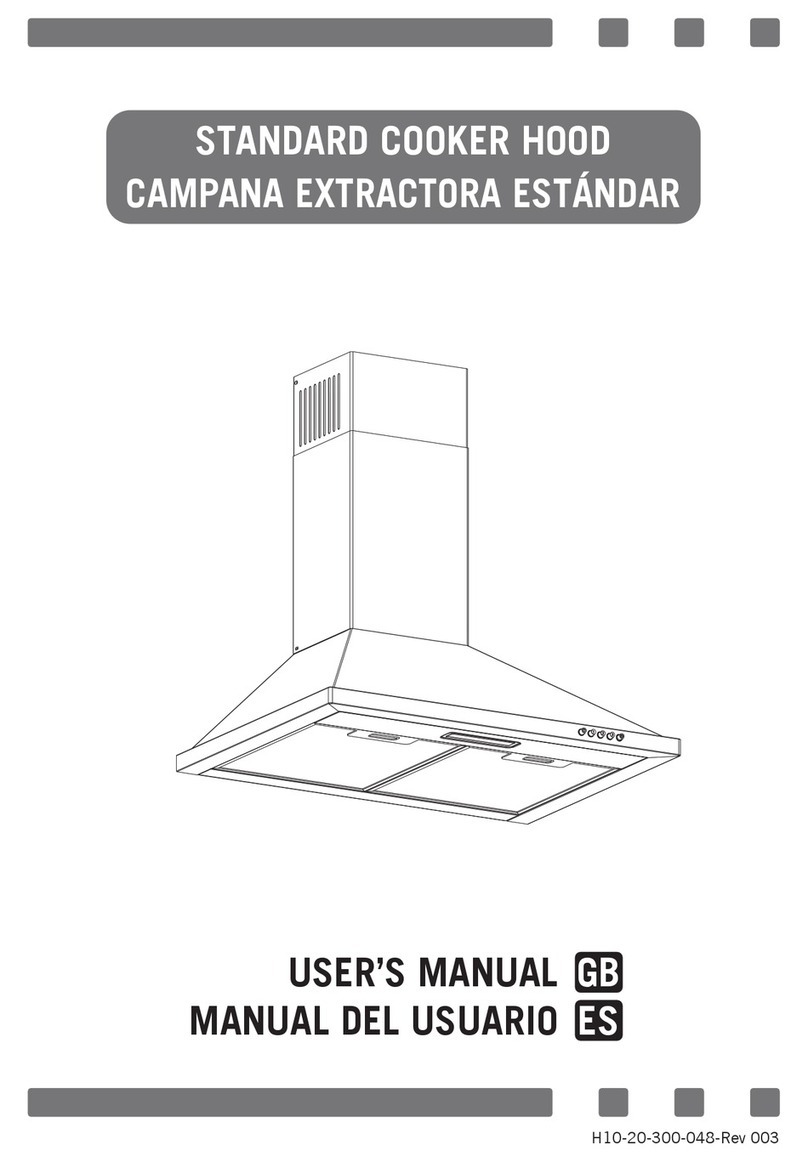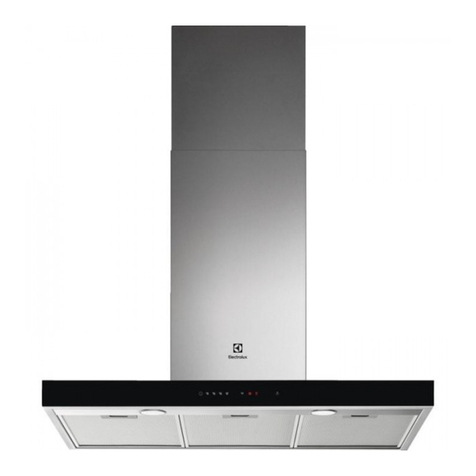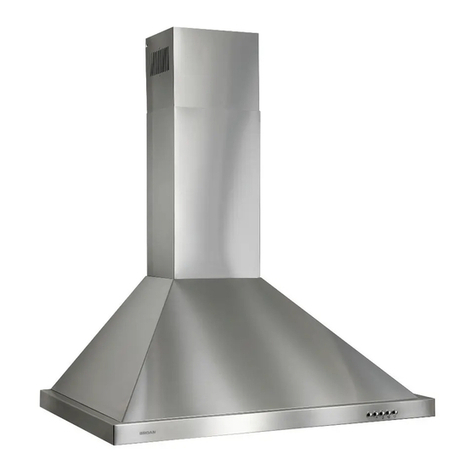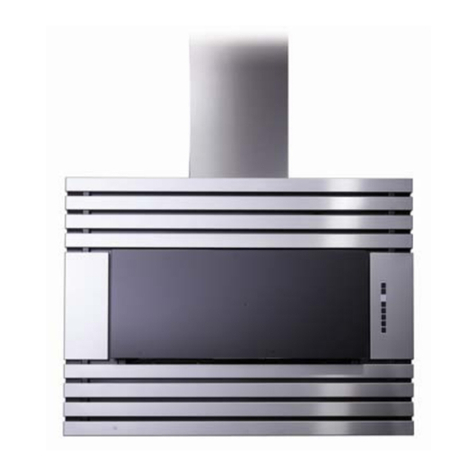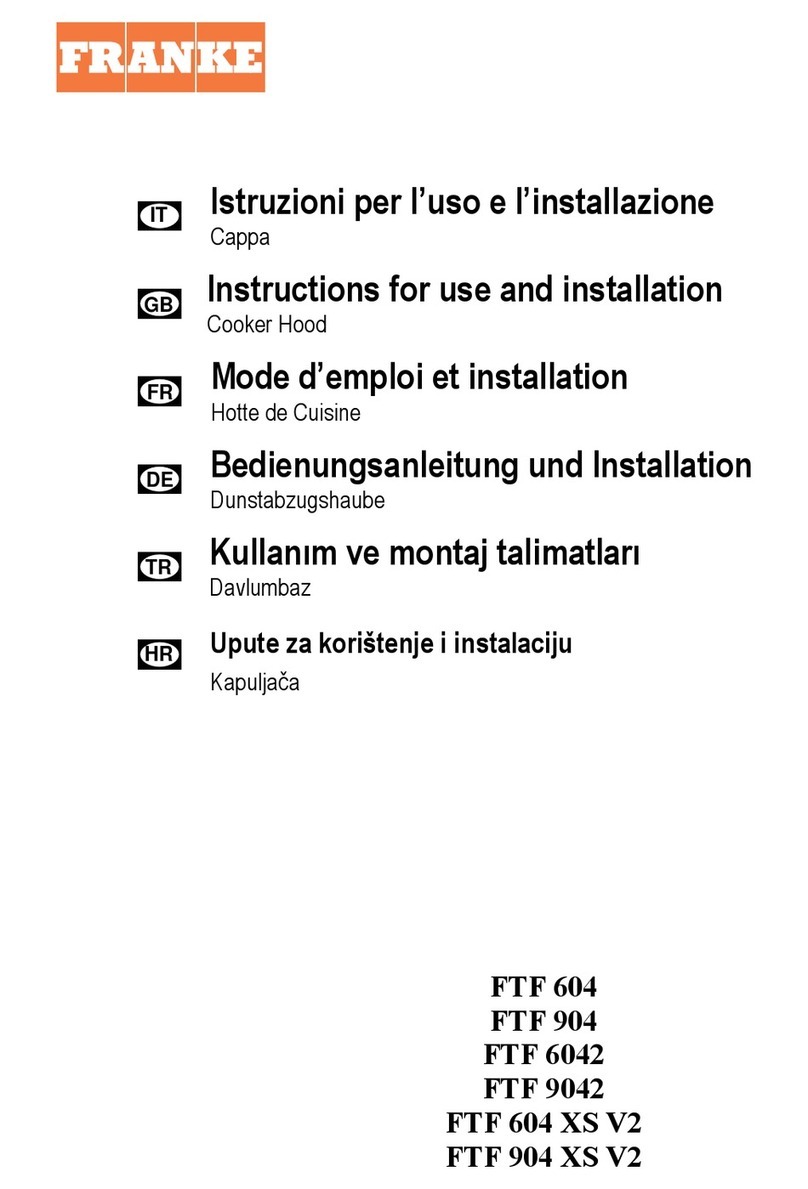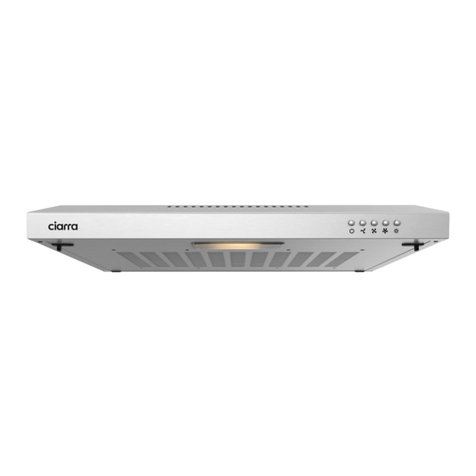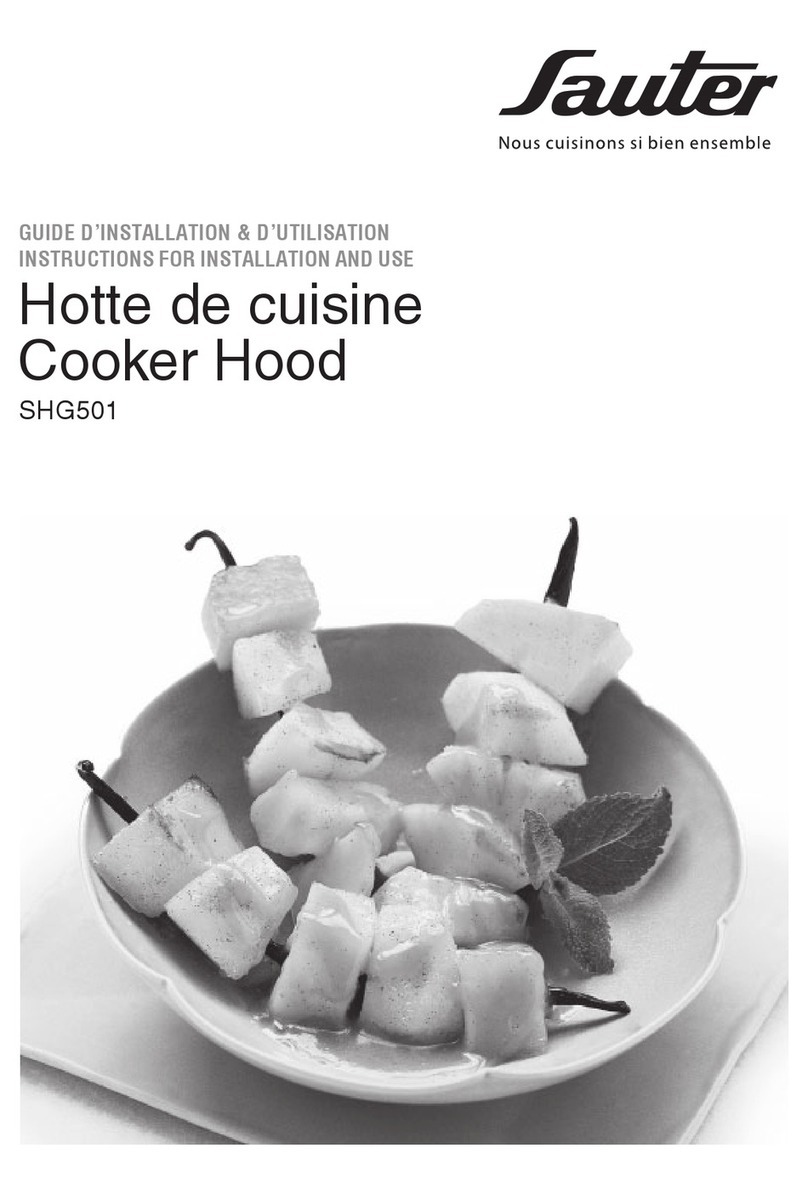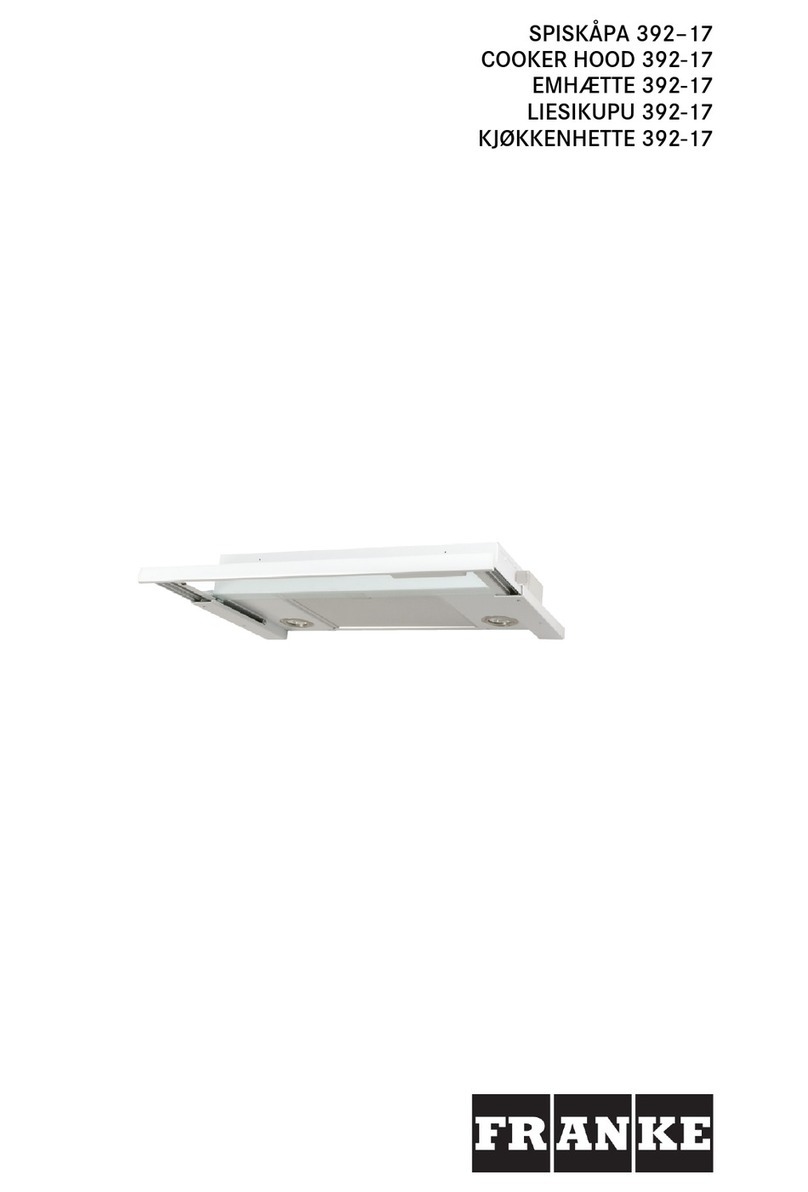ROMMER S 500 User manual

COOKER HOOD
USER INSTRUCTIONS
DUNSTABZUGSHAUBE
GEBRAUCHSANWEISUNG
HOTTE PER CUISINE
MANUEL DUTILISATION
GEBRUIKSAANWIJZING
AFZUIGKAP
MANUAL DE UTILIZACIÓN
CAMPANA EXTRACTORA
MANUAL DO USUÁRIO
CAPPA ASPIRANTE
MANUALE DUSO
VENTILATOR
BRUKERVEILEDNING
BRUGERVEJLEDNING
LIESITUULETIN
ODHGIES CRHSEWS
OKAP
INSTRUKCJE UZYTKOWNIKA
ODSAVAC
NAVOD NA POÙZITÌE
PARAELSZIVÓ
HASZNÁLATI ÚTMUTATÓ
GB
D
F
NL
E
I
P
S
N
GR
RUS
PL
CZ
H
FIN
DK
COIFA ASPIRANTE
SK
ARE
ODSÁVAC PÁR
NÁVOD NA POUITIE
3LIK0092

480
45
240
150
45
C
21
A
B
Z
395
520
23
max 80 cm
G
F
1Mt.
D
90°
A
A
G
F
L
D
90°
90°
L
2Mt.
Fig.2 Fig.3
Fig.1
2

ENGLISH
GENERAL
Carefully read the following important information regarding
installation safety and maintenance. Keep this information booklet
accessible for further consultations.
The appliance has been designed as a exhausting version
(external exhaust) or as a filter version (internal air recycle) cooker
hood.
SAFETY PRECAUTION
1. ake care when the cooker hood is operating simultaneously
with an open fireplace or burner that depend on the air in the
environment and are supplied by other than electrical energy, as
the cooker hood removes the air from the environment which a
burner or fireplace need for combustion.
The negative pressure in the environment must not exceed 4 Pa
(4 x 10 -5 bar).
Provide adequate ventilation in the environment for a safe
operation of the cooker hood.
Follow the local laws applicable for external air evacuation.
2. WARNING!!
In certain circumstances electrical appliances may be a
danger hazard.
A) Do not check the status of the filters while the cooker
hood is operating
B) Do not touch the light bulbs after appliance use
C) Flambè cooking is prohibited underneath the cooker hood
D) Avoid free flame, as it is damaging for the filters and a fire
hazard
E) Constantly check food frying to avoid that the overheated
oil may become a fire hazard
F) Disconnect the electrical plug prior to any maintenance.
INSTALLATION INSTRUCTIONS
• Electric Connection
The appliance has been manufactured as a class II, therefore no
earth cable is necessary.
The connection to the mains is carried out as follows:
BROWN = Lline
BLUE = Nneutral
If not provided, connect a plug for the electrical load indicated on
the description label. Where a plug is provided, the cooker hood
must be installed in order that the plug is easily accessible.
An omnipolar switch with a minimum aperture of 3mm between
contacts, in line with the electrical load and local standards, must
be placed between the appliance and the network in the case of
direct connection to the electrical network.
• The appliance must be installed at a minimum height of 650 mm
from an cooker stove.
If a connection tube composed of two parts is used, the upper
part must be placed outside the lower part.
Do not connect the cooker hood exhaust to the same conductor
used to circulate hot air or for evacuating fumes from other
appliances generated by other than an electrical source.
ATTENTION: should the lamps not work, make sure they are well
tightened.
MOUNTING OF THE HOOD IN THE LOWER PART OF AN
HANGING CUPBOARD
Drill4holes of 6 mm.diameterat the bottomofthe hanging cupboard
as showed in the drawing fig.1.
Fitthehood in thecabinetwith 4screws,which are appropriatetothat
kindofcupboard.
The appliance is provided with 2 air outlets, one which is in the upper
partandthe other ontheback. Both ofthemcan be usedaccordingto
yourrequirements.A connectingring(C), whichtojoin theconnecting
pipe to,and a cover (A) to close the air outlet, which is not used, are
supplied.
3
MOUNTING OF THE HOOD ON THE WALL
Drill 4 holes on the wall, which correspond to the position (B-Z) of the
drawing fig. 1.
Hang the hood on the 2 holes by using the screws and dowels with
expanding plug ,which are aprropriate for that kind of wall (ex.
concrete,plasterboardetc.)
Fix definitely the hood through the 2 security holes (Z).
CHANGING FROM EXHAUSTING HOOD TO FILTERING ONE
In order to make this change, demand a set of carbon filters to your
dealer.Activecarbon filtersarenecessary to depuratethe air, thatwill
be released in the room. Filters are not washable; they cannot be
regenerated and have to be replaced at most every 4 months. The
saturation of the activated charcoal depends on the more or less
prolongeduseof thehood,on thetypeof cookingandon theregularity
of cleaning the grease filter. The filter (D) has to be applied to the
aspiratinggroup,which isinsidethe hoodhiting thecentreof thegroup
with it and turning it of 90 degrees until the stop click is heard to lock
it. Remove the grill (G) to carry out this operation. Close with the
appropriatecoversthe upper andbackair outlets;turnthe small lever
(L) from the position (A) to the position (F). In this way the hood is
ready for the filtering function.
USE AND MAINTENANCE
• It is recommended to operate the appliance prior to cooking.
It is recommended to leave the appliance in operation for 15 minutes
after cooking is terminated in order to completely eliminate cooking
vapours and odours.
The proper function of the cooker hood is conditioned by the regularity
of the maintenance operations, in particular, the active carbon filter.
• The anti-grease filters capture the grease particles suspended in the
air, and are therefore subject to clogging according to the frequency of
the use of the appliance.
In order to prevent fire hazard, it is recommendable to clean the filter
at a maximum of 2 months by carrying out the following instructions:
- Remove the filters from the cooker hood and wash them in a solution
of water and neutral liquid detergent, leaving to soak.
- Rinse thoroughly with warm water and leave to dry.
- The filters may also be washed in the dishwasher.
The aluminium panels may alter in colour after several washes. This
is not cause for customer complaint nor replacement of panels.
• The active carbon filters purify the air that is replaced in the
environment. The filters are not washable nor re-useable and must be
replaced at maximum every four months. The saturation of the active
carbon filter depends on the frequency of use of the appliance, by the
type of cooking and the regularity of cleaning the anti-grease filters.
• Clean the fan and other surfaces of the cooker hood regularly
using a cloth moistened with denatured alcohol or non abrasive
liquid detergent.
THE MANUFACTURER DECLINES ALL RESPONSIBILITY FOR
EVENTUAL DAMAGES CAUSED BY BREACHINGTHE ABOVE
WARNINGS.
ENGLISH

4
ALLGEMEINES
Diese Anleitung bitte aufmerksam durchlesen, da sie wichtige
Sicherheitshinweise zur Installation, zum Gebrauch und zur
Wartung enthält. Die Anleitung für eventuelle zukünftige
Konsultationen aufbewahren.
Das Gerät wurde als Abzugshaube (die angesaugte Luft wird nach
aussen abgeleitet) oder als Umlufthaube (die Luft wird in den
Raum zurückgeleitet) konzipiert.
SICHERHEITSHINWEISE
1. Vorsicht ist geboten, wenn gleichzeitig eine Abzugshaube und
ein raumluftabhängiger Boiler oder ein offenes Feuer in Betrieb
sind, die von einer anderen Energiequelle als Strom versorgt
werden, da die Küchenhaube die Raumluft absaugt, die auch der
Boiler oder das Feuer zur Verbrennung benötigen.
Der Unterdruck im Raum darf den Wert von 4 Pa (4 x 10-5 bar)
nicht übersteigen.
Um einen sicheren Betrieb der Abzugshaube zu gewährleisten,
ist daher immer auf eine ausreichende Belüftung des Raumes zu
achten.
Bei der Ableitung der Luft nach aussen müssen die nationalen
Vorschriften eingehalten werden.
2. ACHTUNG!!
Elektrogeräte können unter gewissen Umständen gefährlich
sein!
A) Niemals die Filter kontrollieren, wenn die Küchenhaube
in Betrieb ist.
B) Niemals die Lämpchen nach längerem Betrieb der
Küchenhaube anfassen.
C) Es ist verboten, Speisen unter der Abzugshaube zu
flambieren.
D) Offene Flammen sind unbedingt zu vermeiden, da diese
die Filter beschädigen und einen Brand verursachen
können.
E) Beim Frittieren sind die Speisen ständig zu kontrollieren,
um die Entzündung des Öls zu vermeiden.
F) Wird das Netzkabel dieser Haube beschädigt, muss es in
einer vom Hersteller zugelassenen Werkstatt ersetzt
werden, da hierzu Spezialwerkzeug benöetigt wird.
G)Vor jeglichenWartungsarbeiten unbedingt den Netzstecker
aus der Steckdose entfernen.
INSTALLATIONSANLEITUNG
• Elektroanschluss
Die Küchenhaube gehört zur Geräteklasse II, daher muss keine
der Leitungen geerdet werden. Der Anschluss an das Stromnetz
ist folgendermassen durchzuführen:
BRAUN = LLeitung
BLAU = Neutrale Linie
Falls nicht vorhanden, muss ein Normstecker mit den auf dem
Typenschild angegebenen Werten an das Kabel angeschlossen
werden. Wenn die Küchenhaube mit einem Netzstecker
ausgestattet ist, muss diese so installiert werden, dass der Stecker
gut zugänglich ist.
Beim Direktanschluss an das Stromnetz muss zwischen Gerät
und Netz ein der Netzlast und den geltenden Vorschriften
entsprechender Mehrpolstecker mit einer Mindestöffnung von 3
mm zwischen den Kontakten installiert werden.
• Das Gerät muss in einem Mindestabstand von 650 mm über
einer kochfäche installiert werden.
Falls einVerbindungsrohr verwendet wird, das aus zwei oder mehr
Teilen zusammengesetzt ist, muss der obere Teil über den unteren
gestülpt werden. Auf keinen Fall darf das Abluftrohr der
Küchenhaube an ein Rohr angeschlossen werden, in dem
Warmluft zirkuliert oder das zur Entlüftung von Geräten verwendet
wird, die an eine andere Energiequelle als an Strom
angeschlossen sind.
• ACHTUNG:Falls die Lampen nicht funktionieren sollten, ist zu
überprüfen,obsie vollständig eingedrehtsind.
• MONTAGE DER HAUBE UNTER DEM HÄNGESCHRANK
4 Löcher (Durchmesser 6 mm) wie in Abb.1 gezeigt in die Unterseite
desHängeschrankesbohren.
Die Haube mit 4 Schrauben befestigen, die der Beschaffenheit des
Möbelsangemessensind.
DasGerätbesitzt zweiAbluftöffnungen,die je nachBedarf gebraucht
werden können. Eine befindet sich im oberen und die andere im
rückwärtigen Teil des Gerätes.
Das Gerät wird mit einem Verbindungsring (C) zum Anschluß des
Verbindungsrohrs sowie mit einem Deckel (A) zum Verschluß der
nichtgebrauchtenAbluftöffnung geliefert.
• WANDMONTAGE DER HAUBE
4 Löcher gemäß der in Abb.1 gezeigten Position (B-Z) bohren.
Haube mittels Schrauben und Spreizdübeln befestigen, die der
Wandbeschaffenheit (z.b. Zement, Gipspappe usw.) angemessen
sind.
Die endgültige Befestigung der Haube erfolgt über die beiden
Sicherheitsbohrungen(Z).
• UMBAU DER AUBZUGSHAUBE IN UMLUFTHAUBE
ZurDurchführungdieses Umbaus,KaufenSie bittebei Ihrem Händler
dienötigen Aktivkohlefilterein. DieAktivkohlefilter dienenzur Reinigung
der durch die auf der Vorderseite der Haube befindlichen Löcher
wieder in den Raum zurückgeförderten Luft. Die KohleFilter können
nicht gewaschen oder regeneriert werden und müssen mindestens
alle 4 Monate ausgetauscht werden. Die Sättigung der Aktivkohle
hängtvonder Betriebsdauer,vonder Artder Kochstelle sowievon der
Häufigkeit der Reinigung des Fettfilters ab. Der Filter (D) mußvordie
imInnernder HaubebefindlicheAnsaugvorrichtung montiertwerden.
DerFilterist auf dieseaufzusetzenund anschließendum90° bis zum
Einrastenzudrehen. Hierzu istdas Gitter (G) abzunehmen,die obere
Abluftöffnung mit dem entsprechenden Deckel zu verschließen und
der Hebel (L) von Stellung (A) in Stellung (F) zu bringen. Das Gerät
funktioniertnunals Umlufthaube.
BENUTZUNG UND WARTUNG
• Es wird empfohlen, die Küchenhaube schon vor sämtlichen
Kochvorgängen der Speisen einzuschalten.
Es wird weiterhin empfohlen, das Gerät nach Beendigung des
Kochvorganges noch 15 Minuten weiterlaufen zu lassen, um die
vollständige Entlüftung der Kochdämpfe zu gewährleisten.
Das einwandfreie Funktionieren der Küchenhaube hängt entscheidend
von der Sorgfalt ab, mit der die Wartungsarbeiten durchgeführt werden,
insbesondere die des Fettfilters und die des Aktivkohlefilters.
• Die Fettfilter haben die Aufgabe, die Fettpartikel in der Abluft zu
binden; die Stärke derVerschmutzung hängt daher von der Häufigkeit
des Gebrauchs der Küchenhaube ab. Um eine mögliche Brandgefahr
zu verhindern, muss der Filter in jedem Fall spätestens alle zwei
Monate auf die folgende Weise gereinigt werden:
- Der Abzugshaube die Filter entnehmen und mit Wasser und einem
flüssigen Neutralreiniger abwaschen. Wenn notwendig, einweichen
lassen.
- Dann gründlich mit lauwarmem Wasser abspülen und abtrocknen
lassen.
- Die Filter können auch in der Geschirrspülmaschine gewaschen
werden.
Nach mehrmaligem Waschen der Aluminiumfilter können
Farbveränderungen auftreten. Daraus resultiert jedoch kein Anspruch
auf einen kostenlosen Ersatz der Paneele.
• Die Aktivkohlefilter dienen dazu, die Luft zu reinigen, die wieder in
den Raum zurückgeführt wird. Die Filter sind weder waschbar noch
wiederverwertbar und müssen spätestens alle vier Monate
ausgewechselt werden. Die Sättigung der Aktivkohle hängt ab von der
mehr oder minder langen Benutzungsdauer der Küchenhaube, von der
Art der zubereiteten Speisen und von der Regelmässigkeit, mit der die
Reinigung des Fettfilters durchgeführt wird.
• Alle auf dem Lüftergehäuse und den anderen Teilen der Haube
angesammelten Rückstände sind regelmässig mit Spiritus oder
neutralem Flüessigkeitsreiniger ohne Scheuermittel zu entfernen.
FÜR SCHÄDEN, DIE AUF DIE NICHTBEACHTUNG DER OBEN
GENANNTEN ANWEISUNGEN ZURUCKZUFÜHREN SIND,
WIRD KEINERLEIVERANTWORTUNG ÜBERNOMMEN.
DEUTSCH

5
GÉNERALITÉS
Lire attentivement le contenu du mode d'emploi puisqu'il fournit
des indications importantes concernant la sécurité d'installation,
d'emploi et d'entretien. Le conserver pour
d' ultérieures consultations:
L'appareil a été réalisé comme hotte aspirante (évacuation air à
l'exterieur) ou filtrante (recyclage air à l'interieur).
CONSEILS POUR LA
SÉCURITÉ
1. Attention, lorsque dans la même pièce vous utilisez
simultanément la hotte à évacuation avec un brûleur ou une
cheminée alimentés par une énergie autre que l'électricité, vous
pouvez créer un problème "d'inversion de flux". Dans ce cas la
hotte aspire l'air nécessaire à leur combustion.
La dépression dans le local ne doit pas dépasser les 4 Pa (4 x 10
-5 bar).
Pour un fonctionnement en toute sécurité, n'oubliez pas de prévoir
une ventilation suffisante du local.
Pour l'évacuation vers l'extérieur, veuillez vous référer aux
dispositions en vigueur dans votre pays.
2. ATTENTION
Dans des circonstances déterminées les électroménagers
peuvent être dangereux.
A) Ne pas controler les filtres pendant que la hotte est en
fonctionnement
B) Nepas toucher les lampes après un emploi prolongé de
l'appareil
C) Il est interdit de cuir les aliments à la flamme sous la
hotte
D) Eviter la flamme libre, parcequ'elle est nuisible pour les
filtres et dangereuse pour les incendies
E) Controler constemment les aliments frits pour éviter que
l'huile surchauffée prenne feu
F) Avant d'effectuer n'importe quel entretien déconnecter
la hotte du réseau électrique.
INSTRUCTIONS POUR
L'INSTALLATION
• Connexion électrique
L'appareil est construit en classe II, pour cela aucun cable ne doit
être connecté avec la prise terre.
La connection avec le réseau électrique doit être éxécutée comme
suit:
MARRON = L ligne
BLEU = Nneutre
Si elle n'a pas été prévue, monter sur le cable une fiche normalisée
pour la charge indiquée sur l'etiquette des caractéristiques. Si
elle est dotée d'une fiche, la hotte doit être installée en sorte que
la fiche soit accessible.
En cas de connection directe avec le réseau électrique, il est
nécessaire d'interposer entre l'appareil et le réseau un interrupteur
omnipolaire avec une ouverture minimale entre les contacts de 3
mm, proportionnel à la charge et correspondant aux normes en
vigueur.
•L’appareil doit être installé à une hauteur minimale de 650 mm
des réchauds.
S'il doit être utilisé un tuyau de connection composé de deux ou
plusieurs parties, la partie superieure doit être à l'exterieur de
celle inferiuere.
Ne pas relier le tuyau d'échappement de la hotte à un conduit
dans lequel circule de l'air chaud ou employé pour évacuer les
fumées des appareils alimentés par une énergie differente de
celle électrique.
• ATTENTION: si les lampes ne devaient pas fonctionner, s’assurer
qu’elles soient completement vissées.
• MONTAGEDELAHOTTEDANSLAPARTIEINFÉRIEUREDU
MEUBLE
Percer 4 trous (diamètre 6 mm) au fond de l’ élément haut comme
illustré dans le dessin fig.1.
Fixer la hotte au dessous de l’élement haut par 4 vis appropriées au
typedemeuble.
L’appareil est pourvu de 2 sorties d’air, l’une qui est située dans la
partiesupérieure etl’autre dansla partiepostérieure, quisont utilisables
selon vos necessités. Sont fournis un anneau de raccordement (C)
auquelestrelié letubede connexion,etun bouchon(A)pour fermerla
sortie d’ air, qui n’est pas utilisée.
• FIXATION DE LA HOTTE AU MUR
Percer4trous au mur,correspondant à laposition(B-Z) dudessinfig.
1.
Accrocher la hotte aux deux trous en utilisant les vis et les chevilles
appropriés au type de mur (ex. ciment, placoplâtre, etc.)
Fixer définitivement la hotte en utilisant les 2 trous (Z) de sécurité.
• TRANSFORMATION DE LA HOTTE ASPIRANTE EN HOTTE
FILTRANTE
Pour effectuer cette transformation , commander à votre fournisseur
unesériede filtresaucharbon actif.Les filtresaucharbon actifservent
pour épurer l’air, qui sera remis dans le milieu. Les filtres ne pouvant
pas être lavés ou rechargés, doivent être remplacés au maximum
tousles4 mois.Lasaturation ducharbonactif dépenddel’emploi plus
oumoinslong de lahotte, selon letypede cuisinièreetla régularitédu
nettoyage du filtre à graisse. Le filtre (D) doit être appliqué au groupe
aspirant,quiest à l’intérieurdela hotte enlecentrant et enle tournant
de 90 degrés jusqu’au déclenchement d’arrêt. Pour cette operation
soulever la grille (G). Fermer la sortie supérieure et postérieure d’air
aveclesbouchons appropriés;tourner la manette(L) delaposition (A)
à la position (F). La hotte est prête à fonctionner en mode filtrant.
EMPOI ET ENTRETIEN
• Nous vous recommandons de mettre la hotte en route avant de
commencer à cuisiner.
Les filtres doivent être appliqués sur le groupe d'aspiration situé à
l'intérieur de la hotte en les centrant et en les faisant tourner de 90
degrés jusqu'au blocage.
Le bon fonctionnement de la hotte est lié à la fréquence des opérations
d'entretien, et plus particulièrement à l'entretien du filtre anti-graisse
et du filtre au charbon actif.
• Les filtres anti graisse ont pour rôle de retenir les particules grasses
en suspension dans l'air. Ils peuvent donc se boucher plus ou moins
rapidement selon l'usage de la hotte.
Dans tous les cas, pour prévenir un éventuel risque d'incendie, il est
nécessaire de nettoyer au moins tous les deux mois le filtre en suivant
les indications suivantes:
- Retirer les filtres de la hotte et les laver avec de l'eau et un détergent
liquide neutre, laisser la saleté se décoller.
- Rincer abondamment à l'eau tiède et laisser sécher.
- Les filtres peuvent également être lavés dans le lave vaisselle.
Après plusieurs lavages des panneaux en aluminium, on peut constater
un changement de leur couleur. Ceci n'ouvre pas droit à réclamation
afin d'obtenir un éventuel changement des panneaux.
• Les filtres au charbon actif servent à filtrer l'air qui sera rejeté
dans la pièce. Les filtres ne sont ni lavables ni régénérables et
doivent être changés tous les trois mois au maximum. La saturation
du charbon actif dépend de l'utilisation plus ou moins prolongée
de l'appareil, du type de cuisine effectué et de la régularité avec
laquelle est effectué le nettoyage du filtre anti graisse.
• Nettoyer fréquemment tous les dépôts sur le ventilateur et les
autres surfaces, en utilisant un chiffon imbibé d'alcool dénaturé
ou de détergents liquides neutres non abrasifs.
ON DECLINE TOUTE RESPONSABILITÉ POUR LES
EVENTUELS DÉGATS PROVOQUÉS PAR L'INOBSERVATION
DES SUSDITES INSTRUCTIONS.
FRANÇAIS
Table of contents
Languages:
Other ROMMER Ventilation Hood manuals
Popular Ventilation Hood manuals by other brands
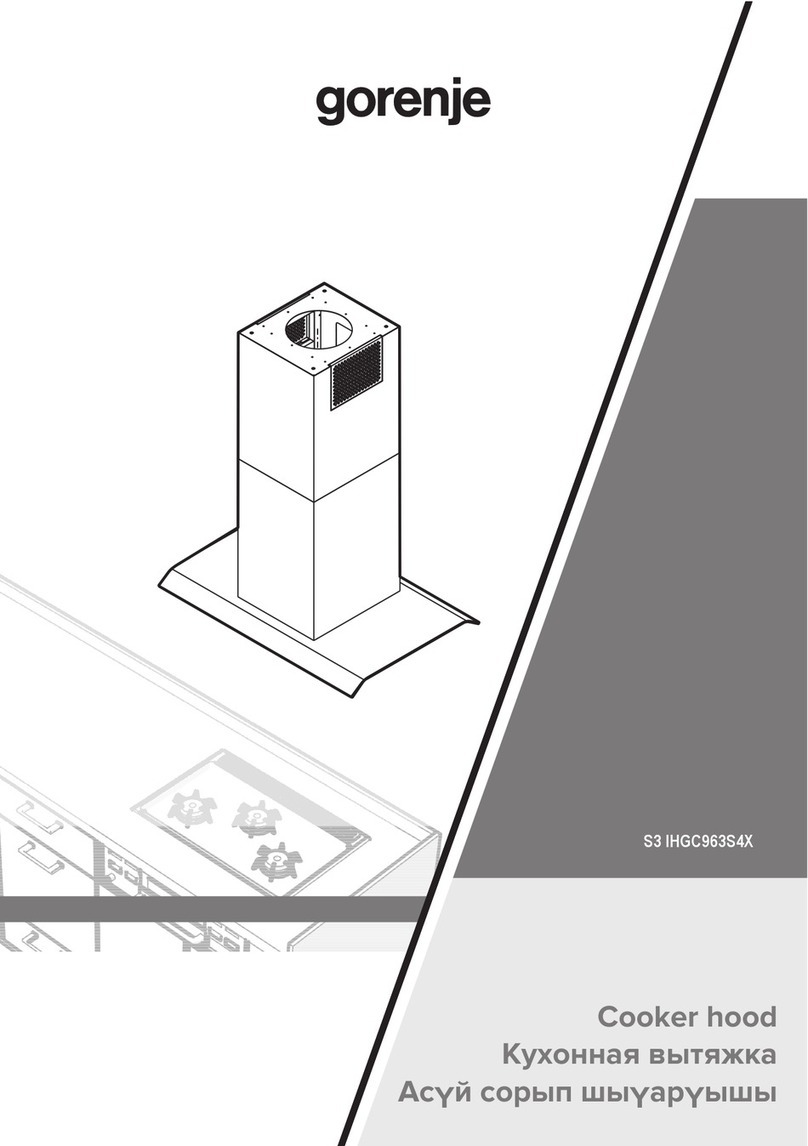
Gorenje
Gorenje S3 IHGC963S4X manual

KOBE
KOBE ISX2136SQB-1 Installation instructions and operation manual

U.S. Products
U.S. Products ADVANTAGE-100H Information & operating instructions

Kuppersberg
Kuppersberg DUDL 4 LX Technical Passport
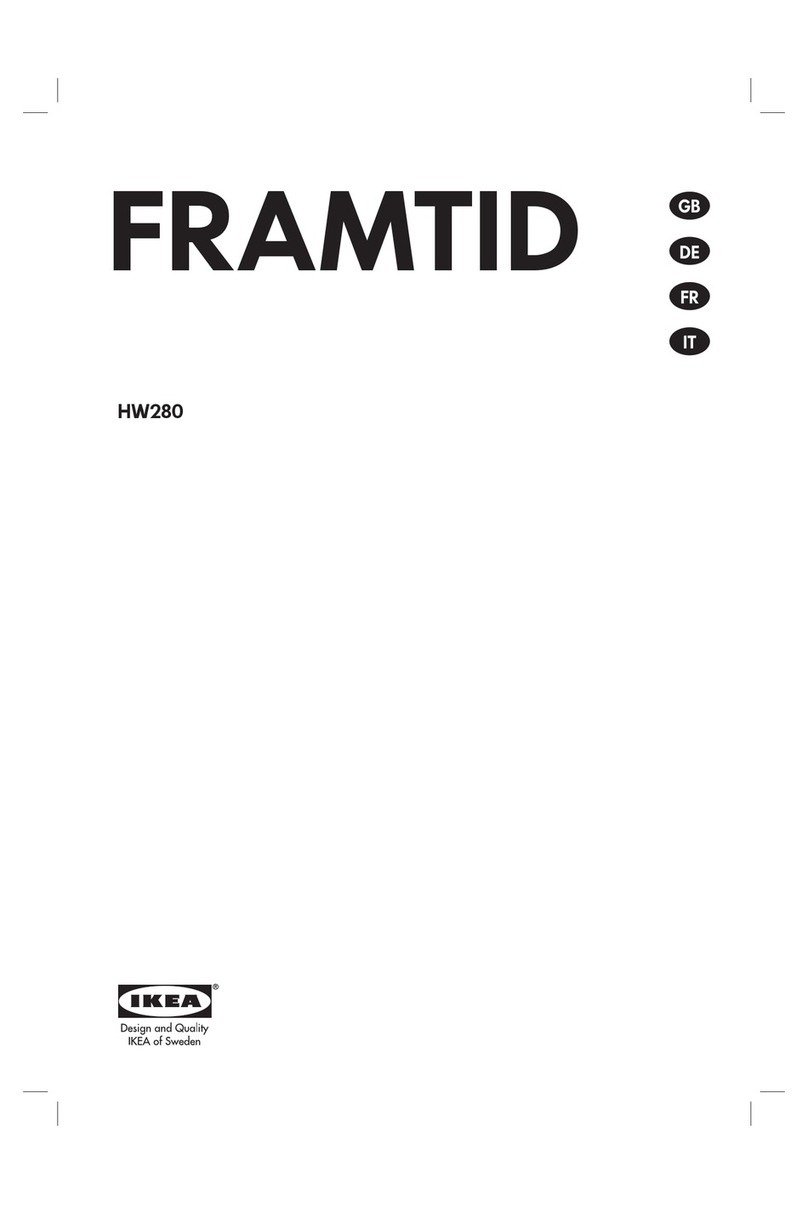
Framtid
Framtid HW280 manual
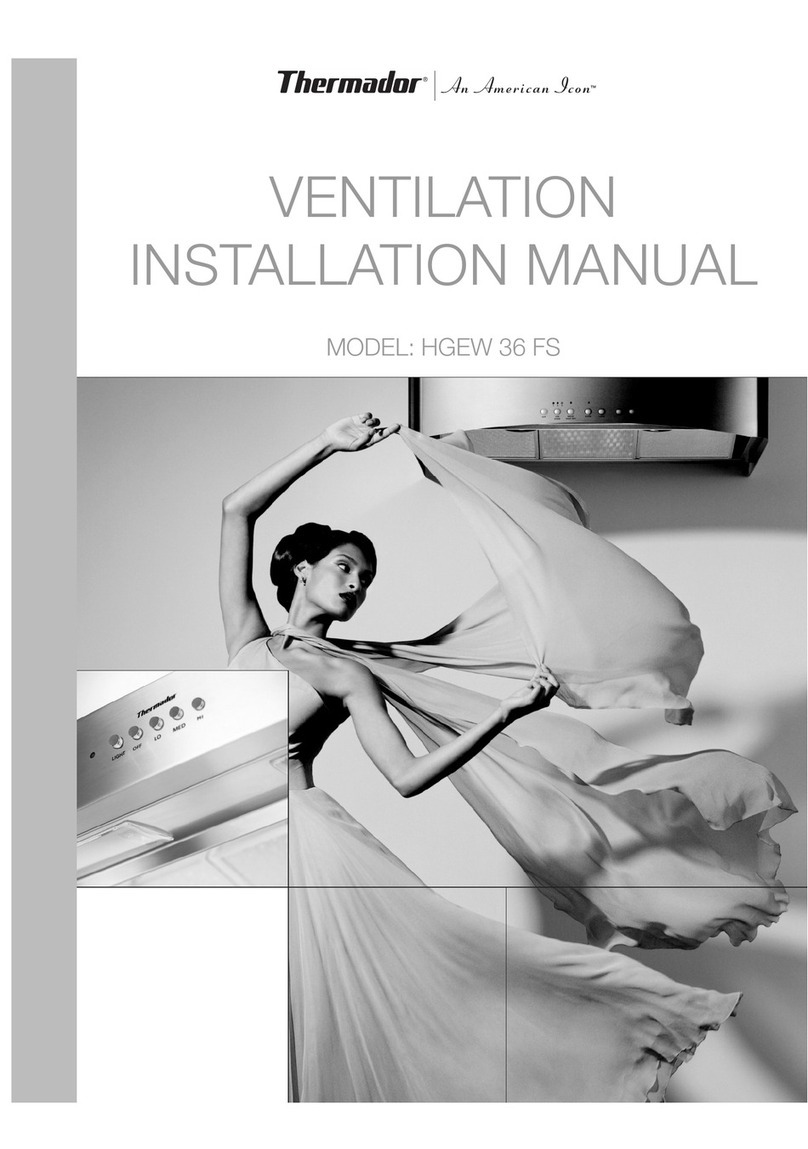
Thermador
Thermador HGEW 36 FS installation manual
